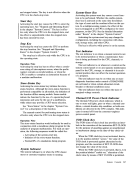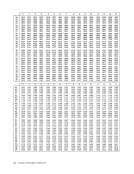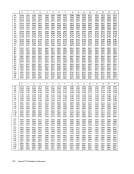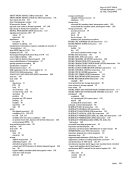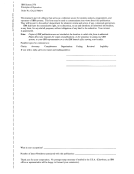channel-end condition. The selector channel handles
this condition as any other interruption condition
from the device after the device has been discon
nected from the channel, and provides zeros in the
protection key, command address, count, and chan
nel status fields of the associated CSW. The
channei-end. condition is not made available to the
program when HALTI/O or HALT DEVICE is
issued to a channel executing a chain of operations
and the device has already provided channel end for
the current operation.
Finally, the third and fourth interruption condi
tions occur when control unit end, if any, and device
end are generated. These conditions are handled as
for any otherI/O operation.
The termination of an operation by HALTI/O or
HALTDEVICE on a multiplexer channel causes the
normal interruption conditions to be generated. If
the instruction is issued when the subchannel is in
the data-transfer portion of an operation, thestib channel remains in the working state until channel
end is signaled by the device, at which time the sub
channel is placed in the interruption-pending state. If
HALTI/O or HALT DEVICE is issued after the
device has signaled channel end and the sub channel
is executing a chain of operations, the channel-end
condition is not made available to the program, and
the sub channel remains in the working state until the
next status byte from the device is received. Receipt
of a status byte subsequently places the sub channel
in the interruption-pending state.
The CSW associated with the interruption condi
tion in the subchannel contains the status byte pro
vided by the device and the channel, and indicates at
what point data transfer was terminated. If HALTI/O or HALT DEVICE is issued before all data
areas associated with the current operation have
been exhausted or filled, incorrect length is indicat
ed, subject to the control of the SLI flag in the cur
rent CCW. The interruption condition is processed
as for any other type of termination.
The termination of a burst operation by HALTI/O or HALT DEVICE on a block-multiplexer
channel may, depending on the model and the type
of subchannel, take place as for a selector channel or
may allow the subchannel to remain in the working
state until the device provides ending status.
Programming Note
The count field in the CSW associated with an oper
ation terminated by HALTI/O or HALT DEVICE
is unpredictable.
Termination by CLEARI/O The termination of an operation by CLEAR I/O causes the subchannel information pertaining to tbe
current operation, if any, with the addressed device
to be stored in the CSW and the subchannel to be.
set to the available state. Unless a channel check had
been detected prior to the execution of CLEARI/O or occurs during the execution of CLEAR I/O, the
contents of the CSW indicate the point at whichtpe channel program was terminated. The count field.
and the incorrect length indication are, however,
unpredictable.
When CLEARI/O terminates an operation at. a
sub channel in the interruption-pending state, up to
three subsequent interruption conditions related to
the operation can occur. Since CLEARI/O causes
the sub channel to be made available, theseinterrup tion conditions will result in only the unit-status por
tion of the CSW being stored.
The first interruption condition arises on a selec
tor channel when channel-end status is presented to
the channel. This occurs only when the interruption
pending status of the channel and subchannel at the
execution of CLEARI/O were due to the previous
execution of HALTI/O or HALT DEVICE.
The second and third interruption conditions arise
when control unit end, if any, and device end are
presented to the channel.
When CLEARI/O terminates an operation at a
sub channel in the working state, up to four subse
quent interruption conditions related to the opera
tion can occur. For all of these conditions, only the
status portion of the CSW will be stored.
The first interruption condition arises on certain
channels when the terminated operation was in the
midst of data transfer. Since the device is not sig
naled to terminate the operation during the execu
tion of CLEARI/O unless the channel is working
with the addressed device when the instruction is
received, the device may, subsequent to the CLEARI/O, attempt to continue the data transfer. The
channel responds by signaling the device to termi
nate data transfer. Depending on the channel, the
need to signal the device to terminate data transfer
may be ignored or may be considered an interface
control check which creates an interruption condi
tion.Only channel status is stored in the CSW.
The second interruption condition occurs when
channel-end status is received from the device. The
third and fourth conditions occur when control unit
end, if any, and device end are presented to the
channel. In these three cases, only unit status is
stored in the CSW.
Input/Output Operations 225
this condition as any other interruption condition
from the device after the device has been discon
nected from the channel, and provides zeros in the
protection key, command address, count, and chan
nel status fields of the associated CSW. The
channei-end. condition is not made available to the
program when HALT
issued to a channel executing a chain of operations
and the device has already provided channel end for
the current operation.
Finally, the third and fourth interruption condi
tions occur when control unit end, if any, and device
end are generated. These conditions are handled as
for any other
The termination of an operation by HALT
HALT
normal interruption conditions to be generated. If
the instruction is issued when the subchannel is in
the data-transfer portion of an operation, the
end is signaled by the device, at which time the sub
channel is placed in the interruption-pending state. If
HALT
device has signaled channel end and the sub channel
is executing a chain of operations, the channel-end
condition is not made available to the program, and
the sub channel remains in the working state until the
next status byte from the device is received. Receipt
of a status byte subsequently places the sub channel
in the interruption-pending state.
The CSW associated with the interruption condi
tion in the subchannel contains the status byte pro
vided by the device and the channel, and indicates at
what point data transfer was terminated. If HALT
areas associated with the current operation have
been exhausted or filled, incorrect length is indicat
ed, subject to the control of the SLI flag in the cur
rent CCW. The interruption condition is processed
as for any other type of termination.
The termination of a burst operation by HALT
channel may, depending on the model and the type
of subchannel, take place as for a selector channel or
may allow the subchannel to remain in the working
state until the device provides ending status.
Programming Note
The count field in the CSW associated with an oper
ation terminated by HALT
is unpredictable.
Termination by CLEAR
current operation, if any, with the addressed device
to be stored in the CSW and the subchannel to be.
set to the available state. Unless a channel check had
been detected prior to the execution of CLEAR
contents of the CSW indicate the point at which
and the incorrect length indication are, however,
unpredictable.
When CLEAR
sub channel in the interruption-pending state, up to
three subsequent interruption conditions related to
the operation can occur. Since CLEAR
the sub channel to be made available, these
tion of the CSW being stored.
The first interruption condition arises on a selec
tor channel when channel-end status is presented to
the channel. This occurs only when the interruption
pending status of the channel and subchannel at the
execution of CLEAR
execution of HALT
The second and third interruption conditions arise
when control unit end, if any, and device end are
presented to the channel.
When CLEAR
sub channel in the working state, up to four subse
quent interruption conditions related to the opera
tion can occur. For all of these conditions, only the
status portion of the CSW will be stored.
The first interruption condition arises on certain
channels when the terminated operation was in the
midst of data transfer. Since the device is not sig
naled to terminate the operation during the execu
tion of CLEAR
with the addressed device when the instruction is
received, the device may, subsequent to the CLEAR
channel responds by signaling the device to termi
nate data transfer. Depending on the channel, the
need to signal the device to terminate data transfer
may be ignored or may be considered an interface
control check which creates an interruption condi
tion.
The second interruption condition occurs when
channel-end status is received from the device. The
third and fourth conditions occur when control unit
end, if any, and device end are presented to the
channel. In these three cases, only unit status is
stored in the CSW.
Input/Output Operations 225
























































































































































































































































